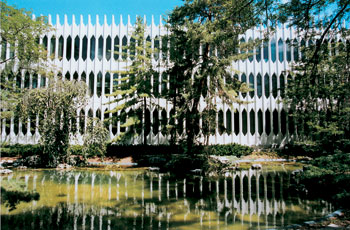Spanning
Two Buildings
by Peter Meredith '02
When high-wire artist Phillipe Petit, credited with humanizing
the World Trade Center's (WTC) towers in 1974 by virtue of his
daring (and illegal) 140-foot tightrope walk between them, came
to Oberlin to participate in a guest artist series last fall,
he must have experienced a fleeting sense of deja-vu.
Oberlin's Conservatory of Music and the College's King Building
were designed by WTC architect Minoru Yamasaki.

Now
artist-in-residence at the Cathedral of St. John the Divine in
New York City, Petit was the season's first "maverick artist"
in Oberlin's "Maverick Artists/Visionary Educators Series,"
sponsored by the Henry Luce Initiative in the Emerging Arts and
coordinated by Luce Professor of the Emerging Arts Linda Weintraub.
Petit found himself at the center of great media interest during
his week-long residency in Oberlin. Arriving a mere six days after
the tragedy, he was sought out by reporters from The New York
Times,
The Los Angeles Times, NPR, and USA Weekly
for his reaction to the events. He told Terril Yue Jones of
The Los Angeles Times, "I felt I was losing my home,
my twin children something very precious."
Learning the WTC and two Oberlin buildings shared an architect,
a reporter from The Wall Street Journal phoned the Conservatory
Public Relations' office just days after the attack, asking whether
or not members of the College and Conservatory were discussing
Yamasaki's relationship to Oberlin. "I explained to the reporter
that although members of the community were aware of the Yamasaki
connection, the community was in the midst of reacting to the
tragedy in terms of loss of life, not in terms of architecture.
Not yet, in any case," says David R. Daniels, Director of
Conservatory Public Relations.
A second-generation Japanese- American, Minoru Yamasaki rose from
poverty to international fame for his distinctive structures.
His designs for the Conservatory and King buildings, constructed
in the early 1960s, share certain characteristics with the WTC,
most notably, the striking vertical grill facades that cloak the
buildings like exterior curtains.
The late Geoffrey Blodgett '52, Professor of History and chronicler
of all things Oberlinian, wrote about that lace-work facade in
Oberlin Architecture, College and Town. From an aesthetic
perspective, he wrote, the Conservatory's "chief virtue is
its glistening beauty as a thing-in-itself, viewed from a distance
on a sunny day. Its repetitive white rhythms, a characteristic
Yamasaki blend of modern Gothic and classical allusions, went
with nothing else in Oberlin."
In a 1959 interview with Virginia Harriman (available on the Smithsonian's
Archives of American Art web
site), Yamasaki had this to say about those repetitive white
rhythms: "We felt that expressing verticality was terribly
important to be sympathetic with the trees through which you always
see the buildings."
With the WTC, a similar grill treatment accentuated the buildings'
height.
The buildings also feature outdoor courtyard areas. The architecture
reflects the surrounding social and physical environments. "The
interesting thing about Oberlin ... is that it is a walking campus,"
said Yamasaki. "We had to think in terms of a walking population
rather than an automobile-transported population. So there are
some little qualities in the building that might be interesting.
As you approach the concert hall, you look at the garden first."
Yamasaki died in 1986 at age 73, but Minoru Yamasaki Associates
of Rochester Hills, Michigan, still has an Oberlin connection
Tae Sun Hong '87 is its senior vice president.


